Question from Jen M.:
Who invented the seat belt?
Jen M..
Author: Invention Geek
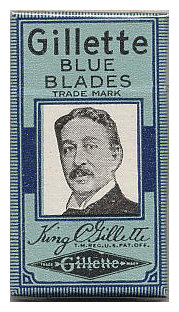 King C. Gillette was inspired to invent the disposable razor by his job as a salesman. He was working for the Crown Cork and Seal Company in the 1890’s selling bottle caps. The inventor of the bottle cap, William Painter, advised Gillette to “invent something people would use and throw away.” Gillette recognized the brilliance of this statement when he saw how successful the Crown Cork and Seal Company had become.
King C. Gillette was inspired to invent the disposable razor by his job as a salesman. He was working for the Crown Cork and Seal Company in the 1890’s selling bottle caps. The inventor of the bottle cap, William Painter, advised Gillette to “invent something people would use and throw away.” Gillette recognized the brilliance of this statement when he saw how successful the Crown Cork and Seal Company had become.
Over the years, Gillette thought of and rejected many possible ideas for disposable products. Then one day, in 1895, he had the idea of producing a safe and disposable razor. When traveling, Gillette would often shave in the bathroom of a train using a safety-razor, which was a heavy blade fit into a wooden handle. This was much safer then using a straight razor but the safety-razor had to be sharpened often and wore out too quickly.
Instead, Gillette wanted to design an inexpensive blade using a piece of steel. The blade could then be replaced easily when it grew dull. For the next six years, Gillette attempted to have such a blade produced. He was told by many experts, including metallurgists at MIT, that it would be impossible to manufacture steel that would be thin, hard and cheap enough. Continue reading “Invent Something People Would Use and Throw Away”
Question from Nelson J.:
Not an earth shattering question but who took out the first patent for bottled water??
Nelson J.
Continue reading “Invention Geek – First Patent for Bottled Water?”
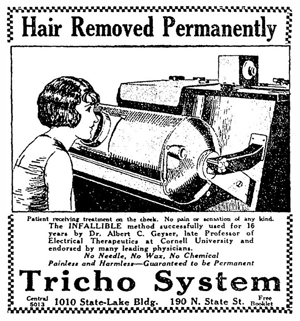 On November 8, 1895, German physicist Wilhelm Röntgen discovered x-ray. The invention was a major scientific breakthrough and the world became fascinated with x-rays. Amazingly, people could now see their bones. X-rays were quickly embraced by physicians and scientists around the world. Physicians began using the machines in their offices. A shoe fitting device using x-rays was patented. There was even a system designed using x-rays to remove excessive hair.
On November 8, 1895, German physicist Wilhelm Röntgen discovered x-ray. The invention was a major scientific breakthrough and the world became fascinated with x-rays. Amazingly, people could now see their bones. X-rays were quickly embraced by physicians and scientists around the world. Physicians began using the machines in their offices. A shoe fitting device using x-rays was patented. There was even a system designed using x-rays to remove excessive hair.
Albert C. Geyser invented the Cornell Tube in 1905. The tube was thought to be a safer form of X-rays. The Cornell tube was an X-ray vacuum tube made of leaded glass with one area of regular glass for shinning an ultra-soft x-ray directly on a small spot of skin. The tube supposedly did not emit extra rays and so it reduced the possibility of being burned by the x-rays.
Geyser used this tube to create the Tricho system. The machine was used to remove unwanted hair from the chin, cheeks and upper lips of women by using direct x-rays. Women sat in front of a cabinet with a window where the x-ray came out. A switch turned on the machine though it seemed like nothing happened besides a slight hum. The machine then switched off automatically. Continue reading “X-Rays To Remove Hair?”
Question from Emma R.:
Hey Geek,
Is it true that Levi Strauss has sued other jean designers over their back pocket stitches?
Emma
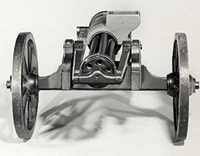 John Gatling was not a man out to promote war and the killing of men with his invention. Instead, Gatling believed that the invention of an automatic weapon would reduce war and the death of soldiers. He thought because the gun would have such a devastating effect on the armies, once seen on the battlefield it would send the other side running. In addition, a weapon that had the impact of many men when used by few would reduce the number of soldiers needed thereby reducing the number of casualties.
John Gatling was not a man out to promote war and the killing of men with his invention. Instead, Gatling believed that the invention of an automatic weapon would reduce war and the death of soldiers. He thought because the gun would have such a devastating effect on the armies, once seen on the battlefield it would send the other side running. In addition, a weapon that had the impact of many men when used by few would reduce the number of soldiers needed thereby reducing the number of casualties.
It occurred to me that if I could invent a machine – a gun – which could by its rapidity of fire, enable one man to do as much battle duty as a hundred, that it would, to a large extent supersede the necessity of large armies, and consequently, exposure to battle and disease [would] be greatly diminished. – John Gatling
Question from E. Henderson.:
Hey Geek,
What is the instrument used for music in spooky movies that you play without actually touching?
E. Henderson
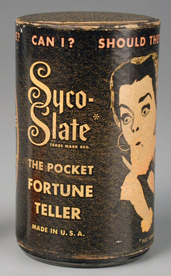 The Magic 8-Ball was inspired by fake seances. Mary Carter, a phony fortune teller, created a spirit writing device. Using a slate enclosed in a box, Carter could secretly write and pretend the spirits were communicating with the device. Her son, Alfred Carter, was amazed by the invention but wanted to make a device that required no skill to use.
The Magic 8-Ball was inspired by fake seances. Mary Carter, a phony fortune teller, created a spirit writing device. Using a slate enclosed in a box, Carter could secretly write and pretend the spirits were communicating with the device. Her son, Alfred Carter, was amazed by the invention but wanted to make a device that required no skill to use.
Alfred Carter created a device he called the Syco-Seer in 1944. The device was a tube divided in half. Each half was filled with a dark liquid and had a die with answers printed on each side. Each end of the tube would reveal different answers when asked a question.
Carter showed his idea to a local merchant in Cincinnati. The merchant wanted to sell the Syco-Seer in his store and distribute the product. Carter asked Abe Bookman, a relative for help with the creation and distribution of the product. They formed Alabe Crafts to produce and market the product. The product name was changed to Syco-Slate: The Pocket Fortune-Teller. In order to generate interest, women dressed like gypsies demonstrated the invention in department stores. Continue reading “The Syco-Seer”
Question from Maggie S.:
Hello Geek,
I have heard many, many different stories about the creation of the Apple logo? What is the true story?
Maggie
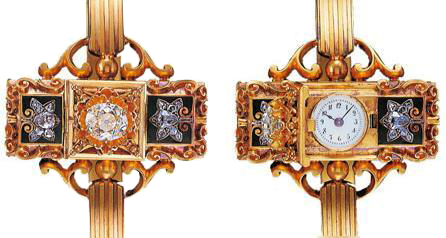 Wristwatches were originally designed for women to be worn as a type of jewelry. The first wristwatch was manufactured by the Swiss watch company, Patek Philippe in 1868. The watch was sold to Countess Koscowicz of Hungary in 1876. The first wristwatch was more ornamental than a time keeping device. It was very ornate, clunky and shaped like a triptych. The time piece was framed by two diamond-and-gold panels and was wound with a key.
Wristwatches were originally designed for women to be worn as a type of jewelry. The first wristwatch was manufactured by the Swiss watch company, Patek Philippe in 1868. The watch was sold to Countess Koscowicz of Hungary in 1876. The first wristwatch was more ornamental than a time keeping device. It was very ornate, clunky and shaped like a triptych. The time piece was framed by two diamond-and-gold panels and was wound with a key.
After the introduction of this watch, it became very popular for women to wear a “lady’s bracelet watch.” A man would never wear a wristwatch as pocket watches were the preferred time keeping device for men. It was not until 1904 when the first wristwatch was actually designed for a man, that the perception changed. Continue reading “Lady’s Bracelet Watch”
